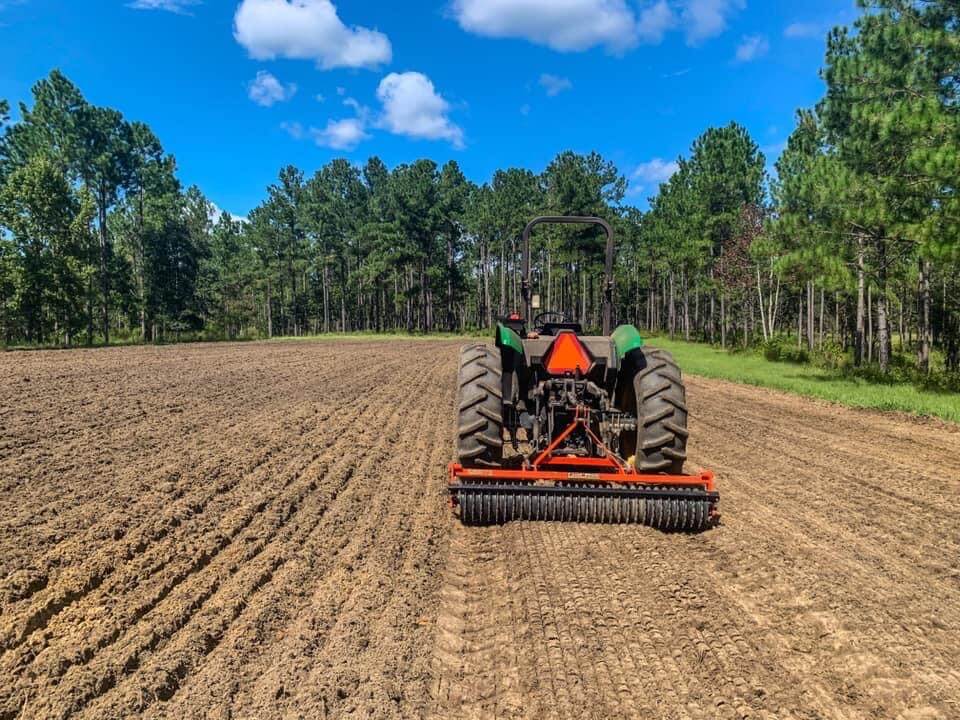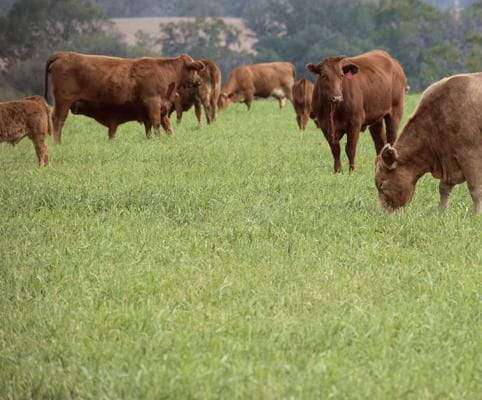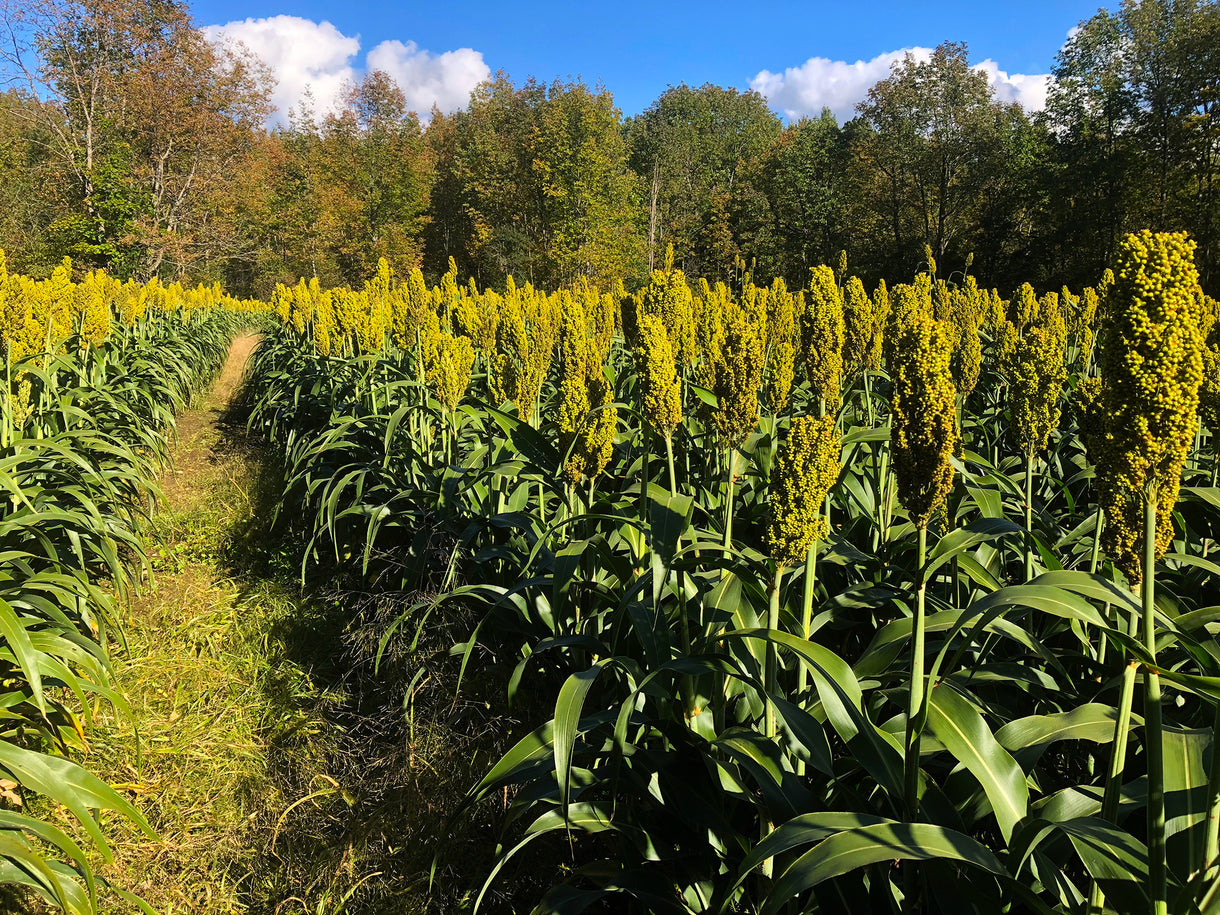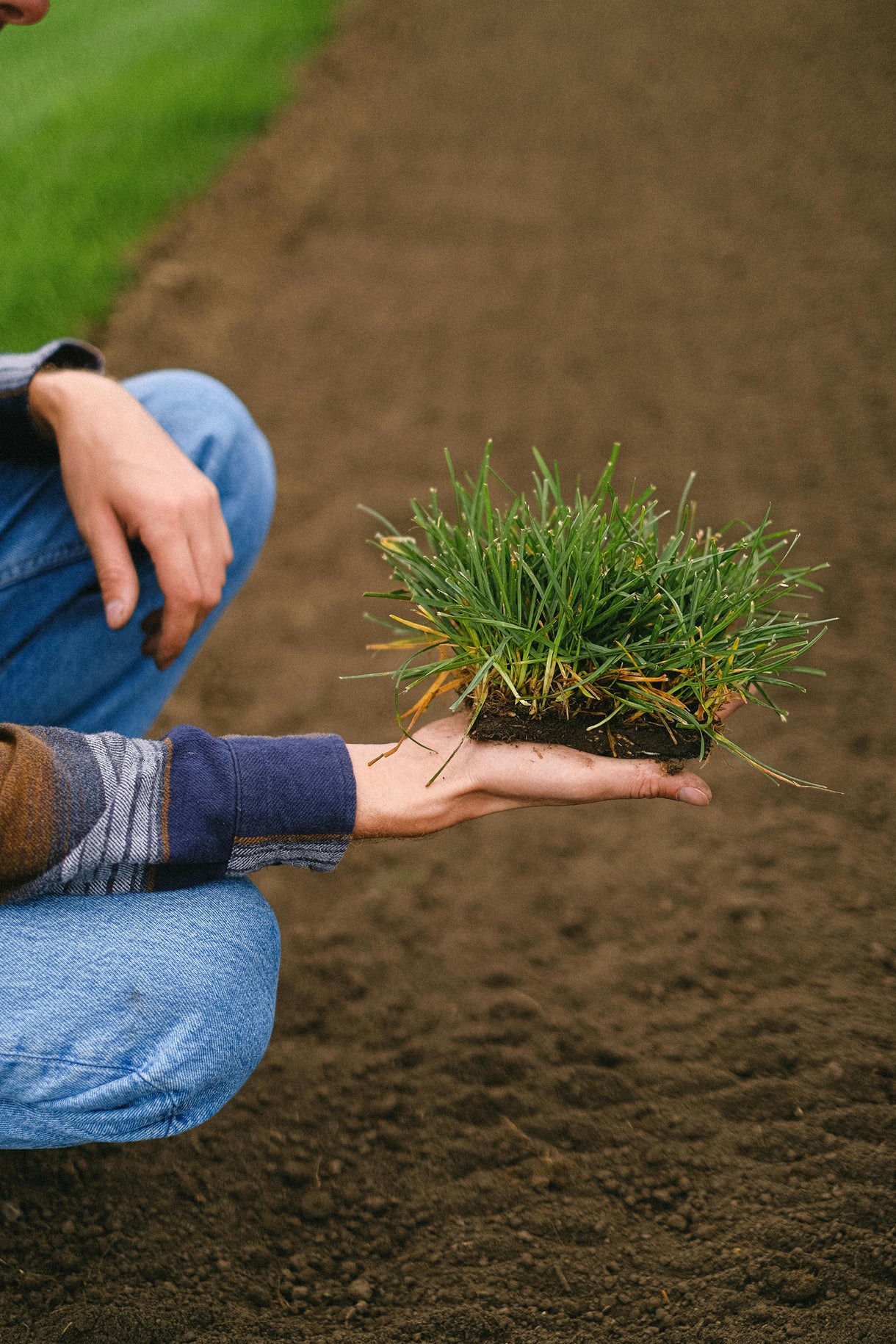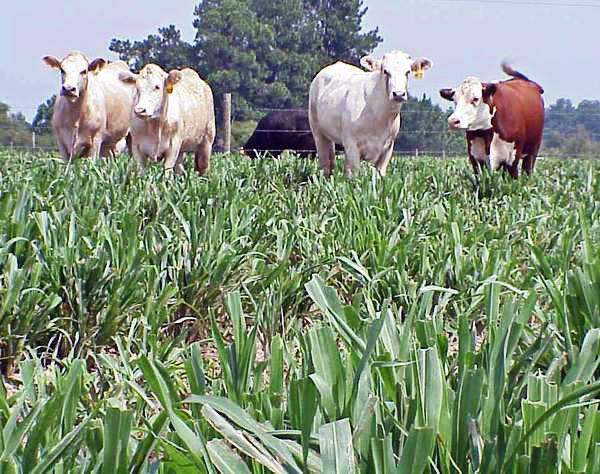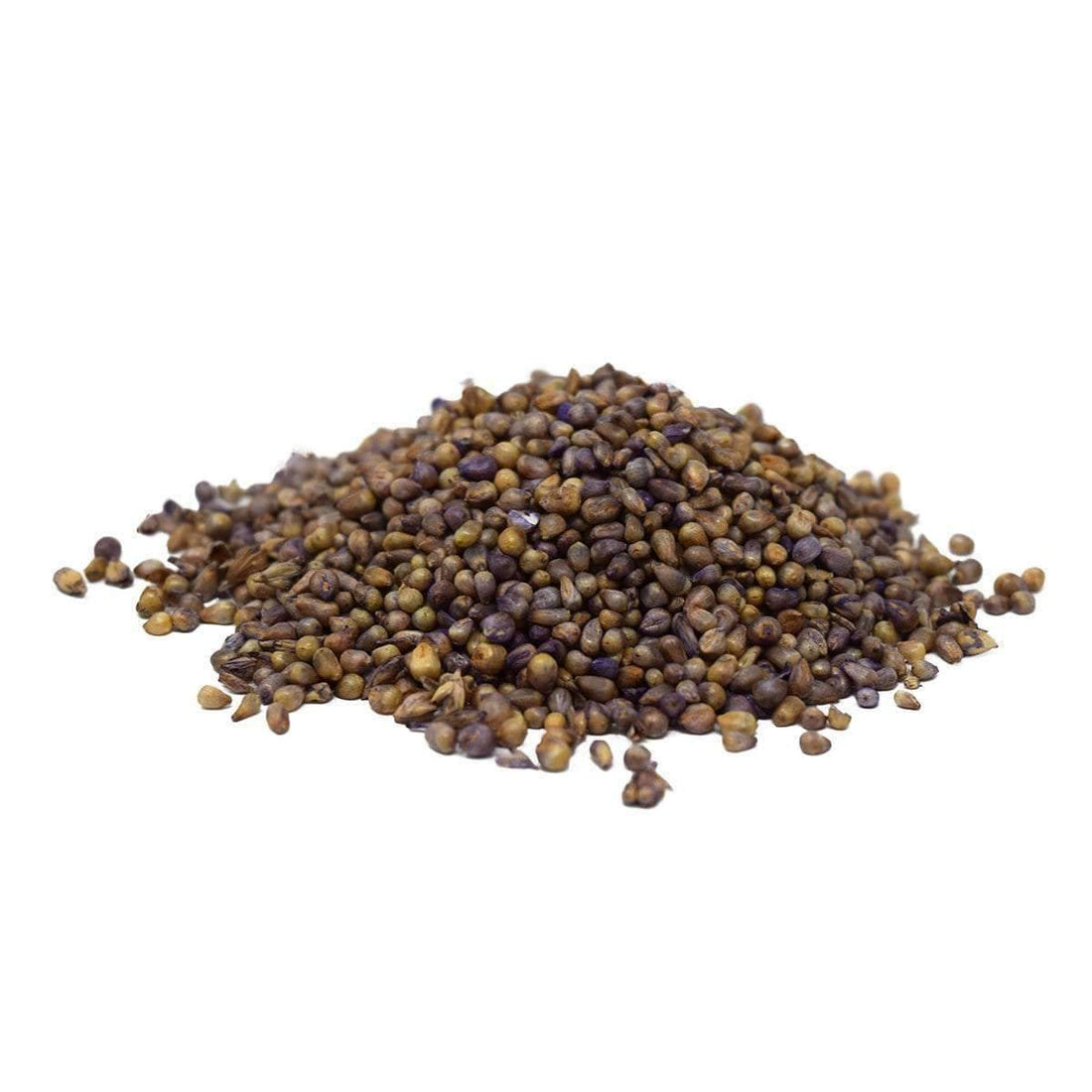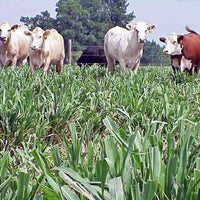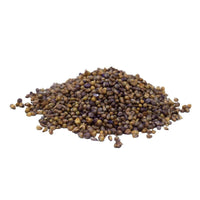Popular Products
Popular Products
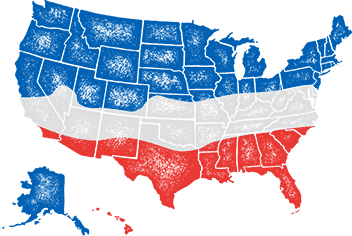
- When to plant:
- Spring, Summer
- Fertilizer:
- Varies
- Seeding rate:
- 25 - 30 lbs. per acre
- Overseeding rate:
- 10 - 25 lbs. per acre
- Seeding depth:
- 1/4 - 1/2 inch
- Ideal ph:
- 5.5 - 7.0
- Gmo:
- No
- Inoculant needed:
- No
- Coated or raw:
- Raw
- Lifecycle:
- Annual
- Climate zones:
- Cool Season, Transition Zone, Warm Season
Tifleaf 3 is a version of Hybrid Pearl Millet Seed that was developed for the most resistance to rust, one of the major diseases impacting Pearl Millet in the United States. The seed carries the same forage quality as other Hybrid Pearl Millets. This is the untreated version of the variety.
Product Details
- Untreated seed
- Warm season annual forage crop
- Great for cattle, sheep, goats, horses and wildlife
- Rapidly growing, high-yielding, high-quality
- Great choice for grazing, hay production, haylage and wildlife food plots
Product Information
Hybrid Pearl Millet Seed is a warm season annual forage crop planted for cattle, sheep, goats, horses and wildlife. Hybrid Pearl Millet is a great choice for summer grazing, hay production, haylage and wildlife food plots. Depending of the weather conditions, Hybrid Pearl Millet can be ready to graze in as little as 30 days after planting.
This version of the Tifleaf 3 Pearl Millet is untreated.
Pearl millet (Pennisetum americanum) and Sorghum-Sudan hybrids (Sorghum x drummondii), are warm-season, rapidly growing, high-yielding, high-quality, annual grasses. They are often planted following small grains, a Spring vegetable crop, or some other cultivated crop. Occasionally they may be planted in a pasture renovation program, where the perennial grass is destroyed and the area is planted with the annual grass. These annual grasses are usually grazed by animals that need a high-quality forage, such as stockers, replacement heifers, first-calf heifers, or dairy cows. Pearl millet and Sorghum-Sudan hybrids are excellent creep pasture for nursing calves and may be harvested as hay, green chop, or silage. Making hay is usually difficult because of the large stems. A hay conditioner is needed, and extra drying days are required compared to making hay with Bermudagrass.
Pearl millet is leafy, with an upright growth habit, and grows 4 to 8 ft. tall. It can be grown on well-drained soils, but does not perform well on calcareous soils or on flatwood sites that flood. Sorghum-Sudan hybrids, although not particularly tolerant of flooded soils, may be the better choice for use on the wetter sites. Pearl Millet is tolerant of drought and acidic soil conditions. The dwarf or semidwarf types such as Tifleaf I, II, and III, are more leafy, with less stem than the taller types, and therefore may be easier to manage under grazing. The taller types may produce more forage dry matter per acre than the dwarf types, but animal production is usually the same. Leaf numbers are usually the same for short and tall types; the differences in total height being due to longer internodes ("distance between the joints") for the taller types.
*Product packaging may appear different than what is pictured.
Pearl Millet can be planted from mid-March through June. Soil temperature must be warm before planting, since seed germination and seedling growth are very sensitive to cool soil conditions. Regrowth from late plantings is less than from earlier plantings. Both Pearl Millet and Sorghum-Sudan hybrids can be broadcast, drilled, or planted in rows. The seeding rate for broadcast plantings is 24 to 30 lbs. per acre. The seeding rate can be reduced for drilled and row plantings. A low seeding rate or poor stand may not be a disaster, since many varieties have excellent tillering capability, and can fill in voids. With the early planting dates, the bulk of the forage is produced from June through August.
Producers should be prepared to graze Pearl Millet rotationally. Millet should reach a height of 14 to 24 in. before each grazing period. Try to graze each pasture down to 6 to 8 in. in one to three days. After a pasture has been grazed, allow it to regrow to a 14 to 24 in. height before re-grazing. When plants start to form heads, removing heads by mowing may prolong vegetative growth. If harvested for hay, cut when plants are approximately 3 ft. high and use a hay conditioner to crush the stems. Harvest for silage in the boot to early-head stage of growth, and if possible, allow to wilt before chopping.
Both Pearl Millet and Sorghum-Sudan hybrids can be grown on low-fertility soils that are moderately acidic. The recommended soil pH for these grasses is 6.0. Apply 30 lbs. of N per acre, 50 percent of the soil-test recommended K2O, and all of the P2O5 in a preplant or at-planting application. Apply 50 lbs. N per acre and the remaining K2O after the first grazing period. Apply an additional 50 lbs. N per acre after each grazing period or harvest as needed.
One important difference between Pearl Millet and the Sorghum-Sudan hybrids is that the Sorghum-Sudan hybrids contain a compound called dhurrin which can break down to release prussic-acid (HCN), and cause poisoning in cattle. Sudangrass has low levels of this compound, Sorghum-Sudan has intermediate levels, and Sorghum has the highest level.. Prussic acid tends to be high in young seedlings and young regrowth. It may be high in both old and young growth when plants are frosted. Therefore, cattle should not be allowed to graze Sorghum-Sudan hybrids until the plants are 24 inches tall, whether initial growth or regrowth. Also, cattle should be removed from Sorghum-Sudan fields when frost is likely to occur. After the frosted plants have dried, which may take 7 to 10 days, they are safe to graze. Prussic acid is not a problem in hay or silage. However, because of the warmer temperatures in south Florida, new tillers may form at the base of frosted plants and this new growth will be high in HCN and will likely be toxic. Remember that these young plants are high in prussic acid and should not be grazed. Also don't green-chop forage, leave in a wagon overnight, and then feed the next day. The heat that occurs in the green-chop will release prussic acid and increase the likelihood of toxicity in the feed. Both Pearl Millet and the Sorghum-Sudan hybrids can accumulate nitrates during a drought if nitrogen is applied just prior to the beginning of the drought. Animals consuming forage high in nitrates may die from "nitrate poisoning." Horses should not be allowed to graze or consume hay made from Sorghum-Sudan hybrids since this may cause a health problem called cystitis syndrome, which is inflammation of the urinary tract.
Cultivars of Millets:
Japanese Millet (Echinochloa crus-galli var. frumentacea) grows 2 to 4 ft. tall. It should not be confused with Pearl Millet. It matures quickly, and thus its forage yield is much less than that of Pearl Millet. A named variety, Chawapa, grows taller and produces more forage than the common Japanese Millet. Japanese Millet is sometimes seeded with a new planting of Bahiagrass to furnish an early grazing or seed crop. Be careful to not let the millet shade out the Bahiagrass seedlings. Japanese Millet is also planted for wildlife feed and for temporary soil stabilization on construction sites.
Browntop Millet (Panicum ramosum) is similar to Japanese Millet in growth habit and use. It is an excellent seed producer and is often planted to provide feed for morning doves and other game birds.
Prosso Millet (Panicum miliaceum) is a bit more cold tolerant than Browntop Millet but has similar uses.
Cultivars of Sorghums:
Grain Sorghums are short in height (3 - 5 ft.) and are not normally considered for forage because of low dry matter yield. Forage Sorghums can grow tall (8 - 13 ft.), have bigger stems and produce a lot of dry matter tonnage. They are difficult to dry because of their large stems. Sorghum-Sudan hybrids are intermediate in height (4 to 7 ft.), have smaller stems, and dry faster.
Tall forage Sorghums are used for silage (Sorghum bicolor) have large-diameter stems and may grow 8 to 10 ft. tall. They are grown almost entirely for use as silage. These hybrids may produce as much grain as the combine-type Grain Sorghums. Therefore, the difference between the two types is mainly in the amount of stalk produced. The shorter-growing Grain Sorghums produce a higher-quality or higher-energy silage than the tall types, but the total forage yield is only 1/2 to 1/3 that of the tall types. The crop should be harvested for silage when the grain is in the milk to soft-dough stage. Delay of harvest beyond this stage results in serious loss of forage quality. Sorghum silage is less digestible and less palatable than Corn silage. Genetic engineering has enabled the creation of a new generation of Brown Midrib (BMR) forage Sorghums that have significantly lower stem lignin concentration and a much improved digestibility equal to that of Corn. The BMR 106, which has 40% more digestibility over conventional forage Sorghums, is a good example of this new technology.
Sudangrass (Sorghum x drummondii) is similar to the Sorghum-Sudan hybrids but is shorter and has finer stems. Yields are lower than the Sorghum-Sudan hybrids. Production, management, and utilization practices are the same as for Sorghum-Sudan hybrids.
Sorghum-Sudan hybrids are similar to Pearl Millet in growth habit, season of production, use, and recommended management practices, but they differ in some ways. Many hybrids produced by private seed companies are available for planting. Select a hybrid that is adapted to your area, has good disease and insect resistance, and tillering capability. Some of the large-stem types do not tiller as well as those with smaller stems. Among the new generation Sorghum-Sudan hybrids with improved forage digestibility are BMR 1000 hybrid forage, BMR 2001 and BMR 3001 Sorghum Sudan grasses.
Crabgrass (Digitaria sanguinalis) is a fine-stemmed annual grass that has been used for both hay and grazing. Crabgrass is a relative of Pangola digitgrass, but unlike Pangola, it can be established from seed. Crabgrass is a reseeding annual and can re-establish itself in the spring if allowed to make seed in the previous growing season. Like Pangola, crabgrass is very palatable and usually more digestible than bahiagrass or Bermudagrass. When volunteer stands develop, a producer may fertilize the grass the same as Bermudagrass and cut it for hay or graze it.
When choosing to start a new lawn, remove old vegetation by using a de-thatcher, power rake or tiller to kill the existing vegetation. Rake or drag the area to remove debris and dead grass for a clean area. Ensure the soil is leveled and loosened to allow the seed to have good soil contact once spread on a clean seed bed.
If you have an area with heavy weed coverage, we recommend starting fresh by killing and removing the existing vegetation. If you choose to use chemicals, herbicides or fertilizers, you must check with the product's manufacturer prior to planting new seed to ensure the proper waiting period.
When overseeding an existing area, mow your lawn at the lowest setting and bag the clippingsx. Rake or drag any areas that have dead thatch or debris.

Seed Quality
Hancock Seed is dedicated to delivering the best seeds possible to our customers. Hancock Seed grows and harvests many of our products, and we acquire the majority of the rest from other family farmers.
All these seeds are processed, packaged and shipped from Hancock Farm. This helps us ensure that our high standards are met. Unlike much of the competition, we refuse to sell you a seed that was not gathered during the last harvest. You will always receive fresh product from Hancock.
Every seed we grow comes with 40 years of experience behind it...you can rest assured that all of our products are cultivated in a method that assures its potential for growth.

Your cart ( 0 )

Tifleaf 3 is a version of Hybrid Pearl Millet Seed that was developed for the most resistance to rust, one of the major diseases impacting Pearl Millet in the United States. The seed carries the same forage quality as other Hybrid Pearl Millets. This is the untreated version of the variety.
Product Details
- Untreated seed
- Warm season annual forage crop
- Great for cattle, sheep, goats, horses and wildlife
- Rapidly growing, high-yielding, high-quality
- Great choice for grazing, hay production, haylage and wildlife food plots
Product Information
Hybrid Pearl Millet Seed is a warm season annual forage crop planted for cattle, sheep, goats, horses and wildlife. Hybrid Pearl Millet is a great choice for summer grazing, hay production, haylage and wildlife food plots. Depending of the weather conditions, Hybrid Pearl Millet can be ready to graze in as little as 30 days after planting.
This version of the Tifleaf 3 Pearl Millet is untreated.
Pearl millet (Pennisetum americanum) and Sorghum-Sudan hybrids (Sorghum x drummondii), are warm-season, rapidly growing, high-yielding, high-quality, annual grasses. They are often planted following small grains, a Spring vegetable crop, or some other cultivated crop. Occasionally they may be planted in a pasture renovation program, where the perennial grass is destroyed and the area is planted with the annual grass. These annual grasses are usually grazed by animals that need a high-quality forage, such as stockers, replacement heifers, first-calf heifers, or dairy cows. Pearl millet and Sorghum-Sudan hybrids are excellent creep pasture for nursing calves and may be harvested as hay, green chop, or silage. Making hay is usually difficult because of the large stems. A hay conditioner is needed, and extra drying days are required compared to making hay with Bermudagrass.
Pearl millet is leafy, with an upright growth habit, and grows 4 to 8 ft. tall. It can be grown on well-drained soils, but does not perform well on calcareous soils or on flatwood sites that flood. Sorghum-Sudan hybrids, although not particularly tolerant of flooded soils, may be the better choice for use on the wetter sites. Pearl Millet is tolerant of drought and acidic soil conditions. The dwarf or semidwarf types such as Tifleaf I, II, and III, are more leafy, with less stem than the taller types, and therefore may be easier to manage under grazing. The taller types may produce more forage dry matter per acre than the dwarf types, but animal production is usually the same. Leaf numbers are usually the same for short and tall types; the differences in total height being due to longer internodes ("distance between the joints") for the taller types.
*Product packaging may appear different than what is pictured.
Pearl Millet can be planted from mid-March through June. Soil temperature must be warm before planting, since seed germination and seedling growth are very sensitive to cool soil conditions. Regrowth from late plantings is less than from earlier plantings. Both Pearl Millet and Sorghum-Sudan hybrids can be broadcast, drilled, or planted in rows. The seeding rate for broadcast plantings is 24 to 30 lbs. per acre. The seeding rate can be reduced for drilled and row plantings. A low seeding rate or poor stand may not be a disaster, since many varieties have excellent tillering capability, and can fill in voids. With the early planting dates, the bulk of the forage is produced from June through August.
Producers should be prepared to graze Pearl Millet rotationally. Millet should reach a height of 14 to 24 in. before each grazing period. Try to graze each pasture down to 6 to 8 in. in one to three days. After a pasture has been grazed, allow it to regrow to a 14 to 24 in. height before re-grazing. When plants start to form heads, removing heads by mowing may prolong vegetative growth. If harvested for hay, cut when plants are approximately 3 ft. high and use a hay conditioner to crush the stems. Harvest for silage in the boot to early-head stage of growth, and if possible, allow to wilt before chopping.
Both Pearl Millet and Sorghum-Sudan hybrids can be grown on low-fertility soils that are moderately acidic. The recommended soil pH for these grasses is 6.0. Apply 30 lbs. of N per acre, 50 percent of the soil-test recommended K2O, and all of the P2O5 in a preplant or at-planting application. Apply 50 lbs. N per acre and the remaining K2O after the first grazing period. Apply an additional 50 lbs. N per acre after each grazing period or harvest as needed.
One important difference between Pearl Millet and the Sorghum-Sudan hybrids is that the Sorghum-Sudan hybrids contain a compound called dhurrin which can break down to release prussic-acid (HCN), and cause poisoning in cattle. Sudangrass has low levels of this compound, Sorghum-Sudan has intermediate levels, and Sorghum has the highest level.. Prussic acid tends to be high in young seedlings and young regrowth. It may be high in both old and young growth when plants are frosted. Therefore, cattle should not be allowed to graze Sorghum-Sudan hybrids until the plants are 24 inches tall, whether initial growth or regrowth. Also, cattle should be removed from Sorghum-Sudan fields when frost is likely to occur. After the frosted plants have dried, which may take 7 to 10 days, they are safe to graze. Prussic acid is not a problem in hay or silage. However, because of the warmer temperatures in south Florida, new tillers may form at the base of frosted plants and this new growth will be high in HCN and will likely be toxic. Remember that these young plants are high in prussic acid and should not be grazed. Also don't green-chop forage, leave in a wagon overnight, and then feed the next day. The heat that occurs in the green-chop will release prussic acid and increase the likelihood of toxicity in the feed. Both Pearl Millet and the Sorghum-Sudan hybrids can accumulate nitrates during a drought if nitrogen is applied just prior to the beginning of the drought. Animals consuming forage high in nitrates may die from "nitrate poisoning." Horses should not be allowed to graze or consume hay made from Sorghum-Sudan hybrids since this may cause a health problem called cystitis syndrome, which is inflammation of the urinary tract.
Cultivars of Millets:
Japanese Millet (Echinochloa crus-galli var. frumentacea) grows 2 to 4 ft. tall. It should not be confused with Pearl Millet. It matures quickly, and thus its forage yield is much less than that of Pearl Millet. A named variety, Chawapa, grows taller and produces more forage than the common Japanese Millet. Japanese Millet is sometimes seeded with a new planting of Bahiagrass to furnish an early grazing or seed crop. Be careful to not let the millet shade out the Bahiagrass seedlings. Japanese Millet is also planted for wildlife feed and for temporary soil stabilization on construction sites.
Browntop Millet (Panicum ramosum) is similar to Japanese Millet in growth habit and use. It is an excellent seed producer and is often planted to provide feed for morning doves and other game birds.
Prosso Millet (Panicum miliaceum) is a bit more cold tolerant than Browntop Millet but has similar uses.
Cultivars of Sorghums:
Grain Sorghums are short in height (3 - 5 ft.) and are not normally considered for forage because of low dry matter yield. Forage Sorghums can grow tall (8 - 13 ft.), have bigger stems and produce a lot of dry matter tonnage. They are difficult to dry because of their large stems. Sorghum-Sudan hybrids are intermediate in height (4 to 7 ft.), have smaller stems, and dry faster.
Tall forage Sorghums are used for silage (Sorghum bicolor) have large-diameter stems and may grow 8 to 10 ft. tall. They are grown almost entirely for use as silage. These hybrids may produce as much grain as the combine-type Grain Sorghums. Therefore, the difference between the two types is mainly in the amount of stalk produced. The shorter-growing Grain Sorghums produce a higher-quality or higher-energy silage than the tall types, but the total forage yield is only 1/2 to 1/3 that of the tall types. The crop should be harvested for silage when the grain is in the milk to soft-dough stage. Delay of harvest beyond this stage results in serious loss of forage quality. Sorghum silage is less digestible and less palatable than Corn silage. Genetic engineering has enabled the creation of a new generation of Brown Midrib (BMR) forage Sorghums that have significantly lower stem lignin concentration and a much improved digestibility equal to that of Corn. The BMR 106, which has 40% more digestibility over conventional forage Sorghums, is a good example of this new technology.
Sudangrass (Sorghum x drummondii) is similar to the Sorghum-Sudan hybrids but is shorter and has finer stems. Yields are lower than the Sorghum-Sudan hybrids. Production, management, and utilization practices are the same as for Sorghum-Sudan hybrids.
Sorghum-Sudan hybrids are similar to Pearl Millet in growth habit, season of production, use, and recommended management practices, but they differ in some ways. Many hybrids produced by private seed companies are available for planting. Select a hybrid that is adapted to your area, has good disease and insect resistance, and tillering capability. Some of the large-stem types do not tiller as well as those with smaller stems. Among the new generation Sorghum-Sudan hybrids with improved forage digestibility are BMR 1000 hybrid forage, BMR 2001 and BMR 3001 Sorghum Sudan grasses.
Crabgrass (Digitaria sanguinalis) is a fine-stemmed annual grass that has been used for both hay and grazing. Crabgrass is a relative of Pangola digitgrass, but unlike Pangola, it can be established from seed. Crabgrass is a reseeding annual and can re-establish itself in the spring if allowed to make seed in the previous growing season. Like Pangola, crabgrass is very palatable and usually more digestible than bahiagrass or Bermudagrass. When volunteer stands develop, a producer may fertilize the grass the same as Bermudagrass and cut it for hay or graze it.
Instructions
When choosing to start a new lawn, remove old vegetation by using a de-thatcher, power rake or tiller to kill the existing vegetation. Rake or drag the area to remove debris and dead grass for a clean area. Ensure the soil is leveled and loosened to allow the seed to have good soil contact once spread on a clean seed bed.
If you have an area with heavy weed coverage, we recommend starting fresh by killing and removing the existing vegetation. If you choose to use chemicals, herbicides or fertilizers, you must check with the product's manufacturer prior to planting new seed to ensure the proper waiting period.
When overseeding an existing area, mow your lawn at the lowest setting and bag the clippingsx. Rake or drag any areas that have dead thatch or debris.






